Recent visits to Yugo restaurants like Kafana left me craving more grilled meat. Something slightly different from my usual Caucasian and Central Asian kebab experiments, yet not completely unrelated — after all, the region was part of the Ottoman Empire for centuries. So this summer I decided to skip the trip to Buffalo and just make my own. And what better way to start than ćevapi, the skinless grilled sausages that you find all over the former Yugoslavia and beyond? Ćevapi originated in the Balkans during the Ottoman period (told you), and my most discerning readers will have noticed that ćevap (singular) is just a distortion of the word kebab. In my head, there’s a whole series of recipes in preparation, via which we explore variations from Slovenia to Romania. But there’s a time for everything, and today we’ll start with Bosnia.
As I like to say, in order to make good kebabs, you need to live in a place where people either worship Allah, or claim they do, or know somebody who does, or else have been invaded by people who do. In this regard, Bosnia, with its 50-something percent Muslim population, is one of the countries that best fits the bill. In fact, if I hadn’t already published my bosanski lonac, I could very well declare ćevapi (or, as they’re affectionately known, ćevapčići) to be Bosnia’s national dish, as they are apparently “eaten by all — young, old, businessman, students and paupers”.
According to that same (Austrian?) website:
Cevapcici are eaten and ordered by five pieces. Women and children mostly order only five. Ten makes a normal portion, but you wouldn’t like to be seen ordering that: MEN order (and eat) 15, 20 or in some extreme cases 25 pieces.
By this account, my servings are measured for half a woman. If you’re a “MAN” — the kind who wears a tracksuit and a gold chain over his chest carpet, loves soccer (but never plays himself), can quote Scarface by rote, and drives a Mercedes (preferably stolen in Germany) — feel free to eat the six servings by yourself, and if you survive to tell the tale you can drop me an insult-laced line in the comment section. I suspect my ćevapi are larger than the norm, but a “MAN” doesn’t let that stop him. Tony Montana wouldn’t let that stop him. Of course, a “MAN” might also just laugh at my recipe. The Austrians again:
Ćevapčići making is delicate process which needs secret rezept and trained professionals. Any misuse can cause bodily injury and serious stomach aches.
Forget all my efforts to make the best grilled meat possible, accompanied by an amazingly puffy lepinja and an ajvar full of intriguing flavors. I’m quite proud of my results, really, but what do I know? For a split second, I was even tempted to press the delete button…

But I didn’t, so prepare for some serious bodily injury if you try my rezept! Is any real “MAN” afraid of serious bodily injury? Hell no!
Bosnian ćevapi are usually made of ground beef, sometimes mixed with ground lamb (no pork, of course), and served with lepinja (a kind of flatbread), chopped onions, kajmak, and ajvar. And this is exactly how we’ll prepare them today, with a few tweaks of my own:
- For the ćevapi, I opted for 50% beef and 50% lamb — that’s just a much more flavorful combo. Some recipes contain onions; mine doesn’t. Then there’s the whole baking soda dilemma, which Serious Eats explains here (and I completely agree with their observations). But grinding the meat three times (or twice if you start with already-ground meat) also plays an important role in the texture, which Serious Eats doesn’t mention at all. It’s the combination of the baking soda and the triple grinding that gives ćevapi their distinctive fine, slightly bouncy texture. If you don’t like bouncy, skip the baking soda or grind the meat only twice. In a perfect world, I’d try all the possible permutations and report in a spreadsheet. In this world, you’ll have to wait until I’m retired, or do it yourself. Careful about the baking soda: you’re supposed to keep it only 30 days after opening, as it absorbs odors.
- For the lepinja, I’ve adapted my own Uzbek non recipe. The main difference is that you poke the non with a fork so that it doesn’t rise, whereas you want the lepinja to puff up so much that the crumb inside separates and creates a pocket, like pita bread, which requires a little bit of practice.
- My ajvar recipe is yet another take on the ever popular eggplant-and-red pepper purées that you find all over Eastern Europe. This time, I’m adding prunes for a hint of sweetness, balanced by the sourness of red wine vinegar and the gentle heat of sweet paprika.
- For the kajmak, I’m mixing equal parts feta (Bulgarian, for its rustic flavor), crème fraîche, and cream cheese. This is the kind of trick that the American Bosnian diaspora uses to avoid making their own kajmak from scratch, and it works great.
- Finally, my chopped onions are a little bit more frou-frou. First, I slice red onion paper-thin, then I toss it with parsley to echo the herbs in the ćevapi, and add kale chips for a nice crunch. You can either make the kale chips yourself or buy them, even if they’re coated with other ingredients. Unless Tony Montana didn’t come to the United States to eat kale chips…
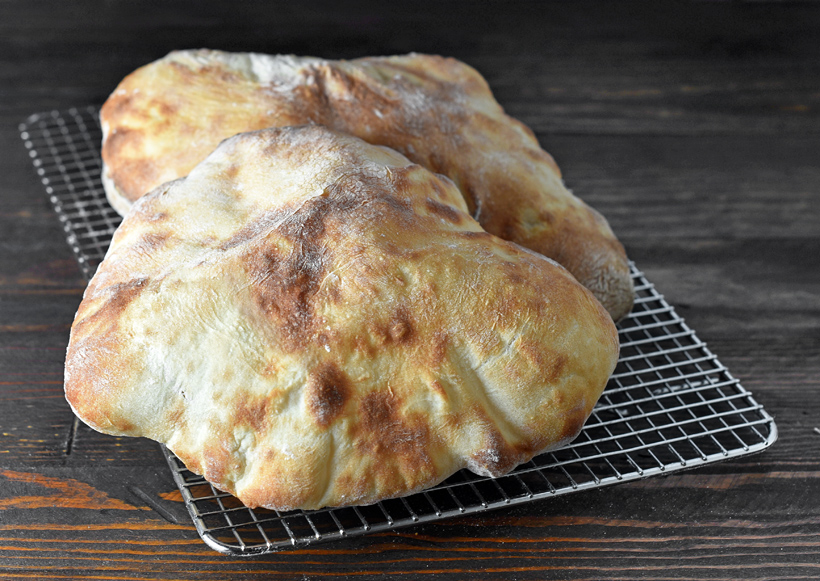
Lepinja
Yields 6 servings (3 flatbreads)
4 g active dry yeast
15 g sugar
30 g milk, lukewarm
300 g water, lukewarm
400 g bread flour
8 g salt
- Sprinkle the yeast and sugar over the milk, stir, and let rest for 5 minutes.
- Transfer to the bowl of an electric mixer fit with the paddle attachment, and add the water. Add half of the flour, then mix over medium speed for 1 minute.
- With the mixer still on, mix in the salt and the rest of the flour in two additions. Mix for about 5 minutes, until the dough is smooth and elastic.
- Cover with plastic wrap, and let rise in a warm place for 1 1/2 to 2 hours, until about doubled in volume.
- Knead the dough again for 1 minute, then cover with plastic wrap and let rise for another hour or so.
- Divide the dough into three pieces. On a generously floured surface, roll each one to a 20 cm diameter disc using a rolling pin. Cover the discs with plastic wrap, and let rest for 15-20 minutes. Make sure there is enough flour on your work surface, so the dough doesn’t stick. As an alternative, you can roll only one ball of dough, and then proceed with the next one while the first one is baking (see below), and so on. You can even let the lepinja rest directly on a pizza peel, saving yourself one handling step.
- Place a pizza stone on the center rack of your oven, and a dish full of hot water on the bottom rack. Heat to 285 C / 550 F.
- Proceeding in batches, transfer each flatbread to the pizza stone, using a floured pizza peel and touching the dough as little as possible (it doesn’t matter if the result is more oval than round). Bake for about 6 minutes, until golden brown. The lepinja should puff significantly, until it almost looks like an American football. It won’t rise as much if you touch the dough a lot when transferring it to the oven. Don’t despair if they don’t rise so well, though; you’ll still have a great meal.
- Remove from the oven, and let cool for a couple minutes.

Kajmak
Yields about 6 servings
70 g Bulgarian feta, crumbled
70 g crème fraîche
70 g cream cheese
- Place the feta, crème fraîche, and cream cheese in a food processor. Process on medium speed until smooth.
- Transfer to a container, and refrigerate.
Ajvar
Yields about 8 servings
265 g eggplant, cut into 1 cm slices
salt
60 g olive oil
1 large red pepper (about 200 g)
15 g peeled garlic, minced
65 g pitted prunes, cut in half
3 g sweet paprika
10 g red wine vinegar
20 g water
- Season the eggplant slices with salt on both sides. Let rest for 10 minutes, then pat dry with paper towels. Proceeding in batches if necessary, sauté the eggplant in about 3/4 of the olive oil until brown on both sides. Remove from the heat, and cut into large dice.
- Char the red pepper with a blow torch. Peel and seed, and collect 110 g of flesh. Cut into medium dice.
- In a pan over medium heat, sauté the garlic in the remaining olive oil until soft. Add the prunes, eggplant, and red pepper. Season with the paprika and some more salt, then cook for a minute, stirring constantly.
- Add the vinegar and water, and cook for another minute. Cover, and simmer over low heat for 30 minutes.
- Transfer the mixture to a food processor, and pulse until still slightly chunky.
- Transfer to a container, and refrigerate.
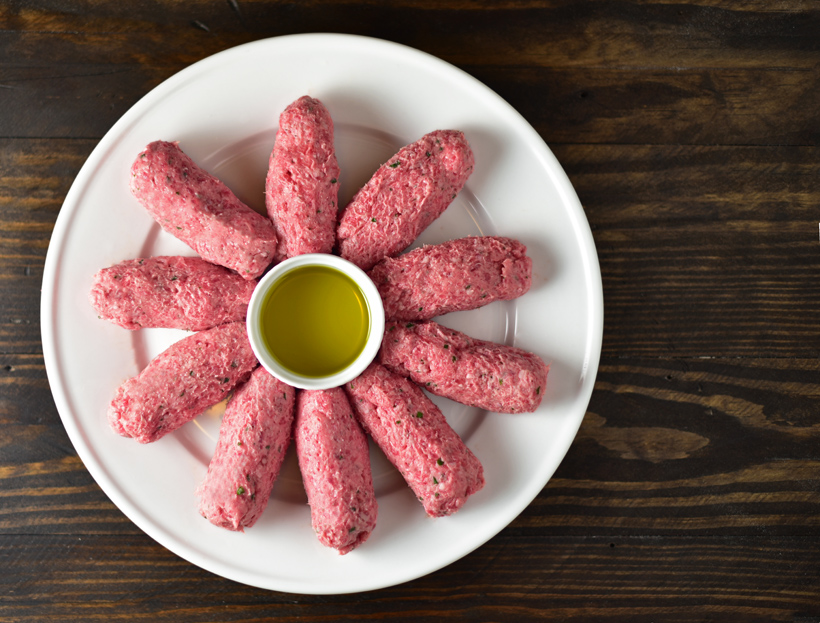
Ćevapi
Yields about 6 servings (15 ćevapi)
14 g peeled garlic, minced
14 g olive oil
500 g ground lamb shoulder
500 g ground beef chuck with 20% fat
7 g flat-leaf parsley, chopped
11 g salt
0.7 g ground black pepper
4 g baking soda
35 g water
- In a small saucepan, sauté the garlic in the olive oil until soft, and let cool.
- In a large bowl, combine the garlic, ground lamb, ground beef, parsley, salt, and pepper. Stir the baking soda into the water, add to the meat, then mix again with a spatula.
- Grind the mixture twice through the small die of a meat grinder. Refrigerate for at least 1 hour.
- Shape the meat into 8-9 cm long, 2.5-3 cm diameter cylinders, of 60-65 g each.
- Cook the ćevapi over a grill on medium heat until brown on all sides. You can use an outdoor wood-fired or gas-fired grill, or even an indoor grill plate. Let rest for a few minutes.
- Before serving, cook the meat again to an internal temperature of about 60 C / 140 F. You can either return the meat to the grill, or finish it in a 175 C / 350 F oven.
- Proceed to next section immediately.
Onion, parsley, and kale garnish
Yields about 6 servings
75 g peeled red onion, very thinly sliced
10 g parsley leaves
about 15 g olive oil
salt
black pepper, ground
about 20 g kale chips
- At the last minute before serving, toss the onion, parsley, olive oil, salt and black pepper together in a small bowl.
- Mix in the kale chips last, so they don’t become soggy.
Assembly
Yields 6 servings
3/4 of ajvar
kajmak
lepinja breads
ćevapi
onion, parsley, and kale garnish
- Take the ajvar and kajmak out of the refrigerator about 15 minutes ahead (or heat in the microwave for 15 seconds).
- Cut each lepinja in half. If the flatbreads have risen properly, the crumb inside should already have separated to create a pocket. If not, cut open with a knife.
- Cut the ćevapi in half lengthwise.
- Within each lepinja half, spread some ajvar on one side and some kajmak on the other Line up 5 ćevapi halves, and add some of the onion, parsley, and kale garnish. Serve!
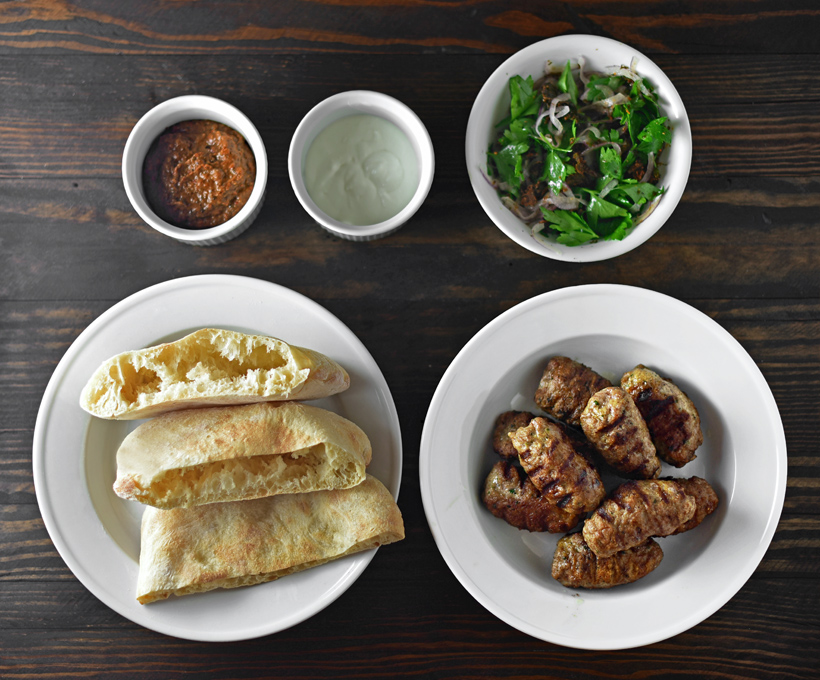

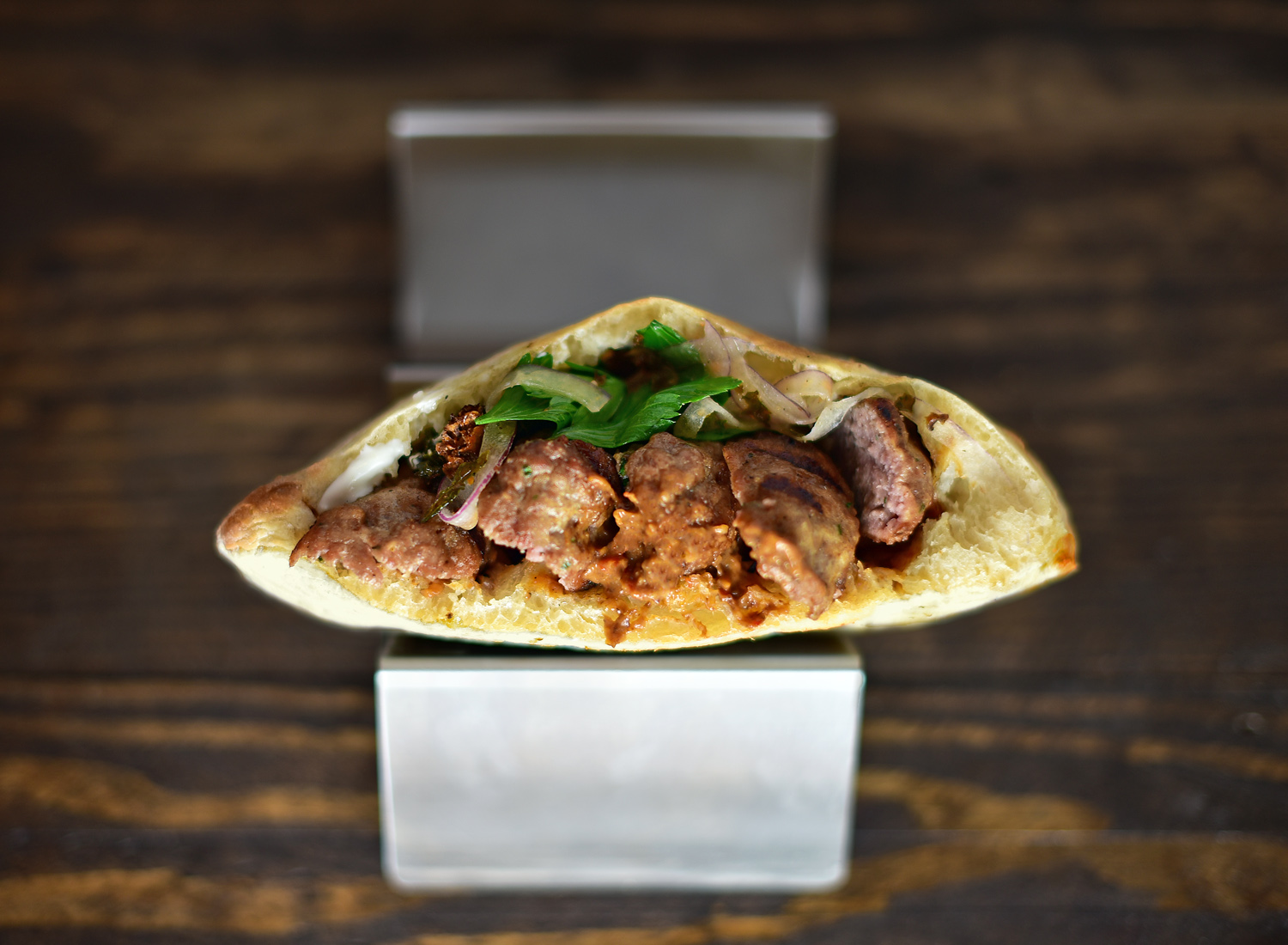


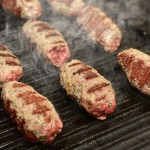
4 comments
Hello! I’ve written for the Croatian, Serbian, and Russian media (mostly about soccer, and yes, I do play as well!) and wanted to say how very much I am enjoying your blog, mostly for the Russian recipes, but this one takes the cake. Amazingly written and looks like a very sound recipe, as well. I look forward to attempting it myself. Cheers!
This is the best lepinja recipe on the internet (in English, at least), no doubt! I looked for ages and this is easily the closest to the bread I ate in Serbia. Well done!
Thank you!!!
Visiting your blog is never enough. you did a great job here. Thank you Sir. I live in Singapore by the way